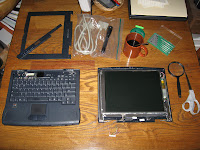To finish the hardware end of the
project, the base assembly needed to be made durable enough to hold
up to the inevitable tugs on the display cable and, as it turned out, gravity. Aesthetics were less
important for the base than the display since it would be in the
background when using the reader. At the same time, I'd see the base
at least when turning the reader on, so I didn't want it to look too
shoddy.
The size of the parallel port I chose to use in my adapter to connect the display cable to the base made it impossible to enclose it within the base housing. I had considered using the laptop's built-in parallel port but dismissed the idea since making the necessary connections would have been hellish. Instead, I decided to run the adapter's wiring along the top of the base and have the parallel port jut out from the back of the base. That way, the keyboard would still be usable if necessary, and the base with the cable connected would remain fairly thin compared to having the port jut upward.
With the adapter plugged into the socket, the added wiring prevented the plastic piece from being replaced on the base giving it a pretty unfinished look. So I cut a chunk out of the plastic piece to allow it to be attached to the base with the wiring extending through it. The adapter's short cable then ran along the top of the plastic piece to the parallel port instead of resting in the groove.
The adapter still needed something to hold it in place. The hinge covers were left over from having removed the display from the base. By screwing these to the plastic piece with a few small wood screws, I managed to repurpose the hinge covers to both hold the adapter in place and cover the tape-constructed adapter cable.

 As an added aesthetic
bonus, the hinge covers' plastic matched that of the base housing.
All in all, I thought the result didn't look half bad.
As an added aesthetic
bonus, the hinge covers' plastic matched that of the base housing.
All in all, I thought the result didn't look half bad.If only that had been enough. Unfortunately, the combined weight of the parallel port and the connector at the base end of the parallel cable leading to the display created a torque around the edge of the base sufficient to lift and pop off the plastic piece intended to hold the adapter in place.
After thrashing around a while thinking about the problem, I concluded that the easiest solution would be to add some type of rigid shelf to hold the port up. I had some scrap sheet metal that could be used but didn't
 want to deal with measuring it and cutting it and smoothing the edges
at that point. Then I remembered a metal plate left over from a past
dissection of a trusted college companion, my old Sharp scientific calculator. Digging the plate out of a closet, I attached it to the
base, and - voila! - I had a shelf for the port. A little
Velcro helped to keep the port in place on the shelf and, lacking the
screw connections on the port housing, to hold the connected cable to
the port.
want to deal with measuring it and cutting it and smoothing the edges
at that point. Then I remembered a metal plate left over from a past
dissection of a trusted college companion, my old Sharp scientific calculator. Digging the plate out of a closet, I attached it to the
base, and - voila! - I had a shelf for the port. A little
Velcro helped to keep the port in place on the shelf and, lacking the
screw connections on the port housing, to hold the connected cable to
the port. But that still
wasn't good enough for me. No, I later decided that the base
just had to rest leaning against a wall on its right side.
That caused gravity to pull the at the port toward the right side in
the picture above, along the surface of the shelf. It eventually got
to be too much for the Velcro, at which point I used some wire to
lash the port to the shelf so it couldn't move in any
direction. Fortunately, the metal plate had holes conveniently
available to be used for the purpose.
But that still
wasn't good enough for me. No, I later decided that the base
just had to rest leaning against a wall on its right side.
That caused gravity to pull the at the port toward the right side in
the picture above, along the surface of the shelf. It eventually got
to be too much for the Velcro, at which point I used some wire to
lash the port to the shelf so it couldn't move in any
direction. Fortunately, the metal plate had holes conveniently
available to be used for the purpose.The end product was a little less than perfect, but that's okay because... It worked!
And that's it for the hardware modifications! Well, almost... After all was said and done, I made one last alteration in the interest of environmentalism, which I'll discuss at a later date.
Still to come... The software side of things...












